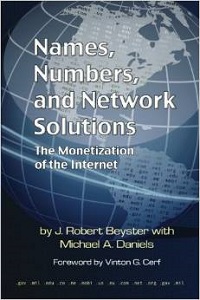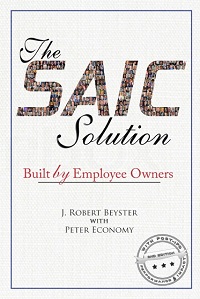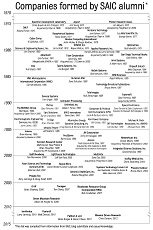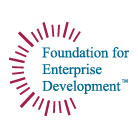La Jolla Village News Article and Rady School of Management Talk
4 Comments Published by Dr. Beyster August 21st, 2007 in The Book.On August 17, an in-depth article appeared in the La Jolla Village News about SAIC — how it worked, and why it was a success. The article reviews the activities over a 35-year period which led to the continuing growth and profitability of SAIC. During this period, of course, SAIC benefited from being an innovative and cutting-edge corporation. It was definitely different from the typical American business environment existing around 1970. We employed two principles that were radical at the time. One was employee ownership. This was at a time when ownership of companies was generally not considered beyond the founder and a close circle of executives. From the beginning, we used company stock to recruit, retain, and motivate employees. As the company grew, the value of employee stock increased accordingly. A second principle was widespread employee participation in decision making, based on performance. Focusing the marketing of the company’s capabilities with federal government agencies and some state agencies was clearly the right thing to do when we started the company, and it would be my recommendation that those who are starting new companies look into that same approach.
On Saturday, August 18, I met with the graduating class from the Rady School of Management at UCSD. This was hosted by their instructor, Bob Nelson, who is a believer in employee ownership and has written or coauthored 16 books himself — some of which have sold over a million copies. I described the company, why I started it, why I chose being a private company and avoided venture capitalists when building the company. We talked about the book — which they had all read — and I answered some questions that they had. It was a rewarding experience for me, and I hope for the students that attended. At present, the Beyster Institute is helping the Rady School — which it is part of — conduct courses in entrepreneurship and employee ownership. This fall, the first course on employee ownership will be given to interested students. They will get academic credit for attending this class, which is in a sense a breakthrough. Not many universities have accredited courses in employee ownership, and we will endeavor to change this as quickly as we can by visiting a number of business schools this fall. We will discuss the value of employee ownership to students and interested members of the faculty, and participate in a question-and-answer session which could be sponsored by the business school, with copies of the book available from a local bookstore should their interest be piqued.
Here are the questions the Rady students asked, along with my answers:
- How important was the concept of teams to SAIC’s success?
The concept of teams at SAIC was important — from the earliest days through my retirement in 2004. What was important was that we needed the best information possible to make decisions, and this we got by discussing the issues with a broad audience.
- What particular challenges and opportunities do teams have for startup technical companies, and then for more established organizations, as SAIC grew?
At SAIC, the team concept was more welcome than in most other companies, where decisions were made by an “in” group and opinions were not sought out. When I think of teams at SAIC, I think about a combination of the relevant technical people, the financial people, the contracts people, risk analysts — I think all of these people are critical for making a decision for whether to bid on a particular procurement. The teams in the field were able to make decisions based on the approval of the group managers when the value of the procurement was less than a few million dollars. Above that, they had to come to me for approval.
- How did you best manage, monitor and motivate teamwork in your career?
Teams were incentivized by special offers of stock options, cash bonuses, and the usual motivators used in building SAIC. The performance of teams was monitored at the division, operation, and group level — as well as corporate — depending upon risk and the amount of money involved in the projects. Foreign business especially drew my attention because we had to carefully adhere to the business rules, along with contracts over $5 million in value.
- What were the most frequent obstacles you encountered regarding teams?
Sometimes the teams were not totally cohesive since more than one group wanted to bid on a procurement, and it wasn’t clear that a successful teaming agreement between groups had been consummated.
- What advice would you give to budding entrepreneurs regarding teams?
My advice would be to constantly monitor the performance of the teams and talk to the customers at the proper level as the work continues. Hopefully, knowledge of progress on the project can be obtained periodically from high-level contacts in the agency who are open to communication.





Dr. Beyster:
I am intrigued by all the questions you got from the Rady students regarding “teams”. (Were all the questions on this subject or was this prompted by some theme of the event?)
I, and some others, have been having an occasional dialog on what the next generation of corporate citizen is going to look and act like. Many people (for instance, Don Tapscott) have been commenting on how (possibly) different the baby boom echo children (the “digital natives†as they have been coined) are going to act when they enter the workforce and the potential difficulties today’s managers are going to have in dealing with them and their “needsâ€. The demographics of this group are impressive – larger even than the baby boom generation (which begins retiring this year apparently – certainly not in my plans!). I am fascinated by what impact this next generation will have upon society in general and corporate enterprises in particular.
One of the common comments about the “kids†is that they have grown up in a collaborative environment in which they are very comfortable working in teams. They have been taught problem solving skills which are centered on teamwork.
This concept is usually contrasted with my generation, which is conventionally thought to have been trained to do individual research and problem solving. (We were rarely, if ever, encouraged to do our homework, for instance, collaboratively.) This is not to say that my generation does not embrace teamwork, however, particularly in engineering, it was accepted to give an individual a small piece of the larger problem to solve independently. There have also been some comments recently that such an individual approach to scientific and engineering problem solving is one of the current issues for large technical organizations like NASA however.
We need, by the way, more pictures and details of that new boat…
Bill: The theme of my meeting with the Rady MBA graduating class was teams, and the value of forming teams — both within an organization, and outside of an organization when it enhances your chances of winning. I was also asked if employee ownership enhances the success of teams. And of course, as you know, my belief is that some employee ownership is better than none. I tend to recommend to new companies that management and key employees retain control of the company — both through ownership, and board control by employees in the early stages of constituting the board. Regarding the new emphasis on teamwork among our younger generation, it’s definitely a valuable quality to develop early among students. However, although we worked in teams when I was in high school, in college, the importance of grades was so high — encouraged by instructors — that I worked alone. Those evaluating student performance had to be sure that the class was not sharing information that they were not permitted to discuss — particularly at exam time. Of course, regardless of the extent of employee ownership in the organization, team efforts are usually encouraged in all projects, and cash bonuses are awarded on both an individual and team basis. — Bob
Bob,
Reading your post above, I saw that you will be shopping the idea of classes in employee ownership to various B-schools this fall. As a recent graduate of the Mason School of Business at the College of William & Mary (tuition paid courtesy of SAIC’s employee tuition reimbursement plan–thank you!), I would love to see W&M join the list of schools offering such a class. I’m not sure which professor at Mason would teach it, but I can certainly provide a list of people to contact at the school. I certainly hope they will be willing to consider it.
Jonathan: We are planning a trip this fall to a number of business schools to argue the case for employee ownership and attempt to interest the schools in sponsoring a course in employee ownership. We can send our book to the head of the business school at William & Mary. If there is a favorable reaction and a chance of faculty interest, then we’ll come to see you when we’re back East.